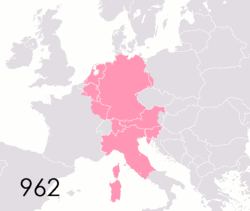পবিত্র রোমান সাম্রাজ্য
পবিত্র রোমান সাম্রাজ্য Sacrum Romanum Imperium | |||||||||||||||||||||||||||||||||||||||||
|---|---|---|---|---|---|---|---|---|---|---|---|---|---|---|---|---|---|---|---|---|---|---|---|---|---|---|---|---|---|---|---|---|---|---|---|---|---|---|---|---|---|
| ৯৬২–১৮০৬ | |||||||||||||||||||||||||||||||||||||||||
জাতীয় সঙ্গীত: (আনুষ্ঠানিক সংগীত নেই) "ঈশ্বর সম্রাট ফ্রান্সিসকে রক্ষা করুন" (রাজকীয় সঙ্গীত, ১৭৯৭) "God Save Emperor Francis" | |||||||||||||||||||||||||||||||||||||||||
 The Holy Roman Empire at its greatest extent during the Hohenstaufen dynasty (1155–1268), superimposed on present-day state borders | |||||||||||||||||||||||||||||||||||||||||
 বর্তমান দেশগুলোর সীমান্ত চিহ্নিত অবস্থায় পবিত্র রোমান সাম্রাজ্যের সীমানা পরিবর্তন | |||||||||||||||||||||||||||||||||||||||||
| রাজধানী | কোন আনুষ্ঠানিক রাজধানী নেই[ক] | ||||||||||||||||||||||||||||||||||||||||
| প্রচলিত ভাষা | বিবিধ [খ] | ||||||||||||||||||||||||||||||||||||||||
| ধর্ম | রোমান ক্যাথলিকবাদ[গ] প্রোটেস্ট্যান্টবাদ[ঘ] | ||||||||||||||||||||||||||||||||||||||||
| সরকার | Elective monarchy | ||||||||||||||||||||||||||||||||||||||||
| সম্রাট | |||||||||||||||||||||||||||||||||||||||||
• ৯৬২–৯৭৩ | Otto I (first) | ||||||||||||||||||||||||||||||||||||||||
• ১৭৯২–১৮০৬ | Francis II (last) | ||||||||||||||||||||||||||||||||||||||||
| আইন-সভা | Imperial Diet | ||||||||||||||||||||||||||||||||||||||||
| ঐতিহাসিক যুগ | মধ্য যুগ আদি আধুনিক যুগ | ||||||||||||||||||||||||||||||||||||||||
• Otto I is crowned Emperor of the Romans | ২ ফেব্রুয়ারি ৯৬২ | ||||||||||||||||||||||||||||||||||||||||
• Conrad II assumes crown of Burgundy | ২ ফেব্রুয়ারি ১০৩৩ | ||||||||||||||||||||||||||||||||||||||||
• Peace of Augsburg | ২৫ সেপ্টেম্বর ১৫৫৫ | ||||||||||||||||||||||||||||||||||||||||
• Peace of Westphalia | ২৪ অক্টোবর ১৬৪৮ | ||||||||||||||||||||||||||||||||||||||||
• Battle of Austerlitz | ২ ডিসেম্বর ১৮০৫ | ||||||||||||||||||||||||||||||||||||||||
• Francis II abdicated | ৬ আগস্ট ১৮০৬ | ||||||||||||||||||||||||||||||||||||||||
| জনসংখ্যা | |||||||||||||||||||||||||||||||||||||||||
• ১২০০ | 5000000[১] | ||||||||||||||||||||||||||||||||||||||||
• ১৫০০ | 16000000[২][৩] | ||||||||||||||||||||||||||||||||||||||||
• ১৬১৮ | 21000000[৪] | ||||||||||||||||||||||||||||||||||||||||
• ১৬৪৮ | 16000000[৪] | ||||||||||||||||||||||||||||||||||||||||
• ১৭৮৬ | 26265000[৫] | ||||||||||||||||||||||||||||||||||||||||
| |||||||||||||||||||||||||||||||||||||||||
| বর্তমানে যার অংশ | |||||||||||||||||||||||||||||||||||||||||
জার্মান জাতির পবিত্র রোমান সাম্রাজ্য (ইংরেজি: Holy Roman Empire of the German Nation, জার্মান: Heiliges Römisches Reich Deutscher Nation) মধ্য ইউরোপে ৯৬২ থেকে ১৮০৬ সাল পর্যন্ত অস্তিত্বশীল ছিল। এর শাসনকর্তা ছিলেন পুণ্য রোমান সম্রাট বা হলি রোমান সম্রাট। মধ্যযুগ এবং আদি-আধুনিক যুগে সম্রাজ্যের রূপ বেশ পরিবর্তিত হয়, সম্রাটদের ক্ষমতা কমতে থাকে এবং বাড়তে থাকে রাজপুত্র বা প্রিন্সদের ক্ষমতা। শেষ শতকে এসে একে কেবল কিছু সার্বভৌম অঞ্চলের জোট ছাড়া আর কিছু বলা যেতো না।
সম্রাজ্যটির কেন্দ্র ছিল জার্মানিতে, যাকে তখন জার্মান সম্রাজ্য বলা। জার্মানি এবং আশপাশের কিছু অঞ্চল নিয়ে এই কেন্দ্র গঠিত হয়েছিল। স্বর্ণযুগে এই সম্রাজ্যের অধীনে ছিল ইতালীয় সম্রাজ্য এবং বুর্গুন্ডি সম্রাজ্যের মত বড় বড় অঞ্চল। অধিকাংশ সময় জুড়ে সম্রাজ্যটির মধ্যে কয়েক শত উপ-বিভাগ ছিল, যেমন প্রিন্সিপালিটি, ডুকি, কাউন্টি, মুক্ত রাজকীয় শহর (ফ্রি ইম্পেরিয়াল সিটি) এবং অন্যান্য ডোমেইন।
৯৬২ সালে অটো ১ জার্মানির সম্রাট ঘোষিত হন, অনেকের মতে তিনিই প্রথম পুণ্য রোমান সম্রাট যাকে জার্মান ভাষায় বলা হতো রোমিশ-ডয়চার কাইজার। অবশ্য রোমান সম্রাটের পদবী প্রথম আনুষ্ঠানিকভাবে দেয়া হয়েছিল শার্লেমাইনকে। অটো ছিলেন এই অংশের প্রথম সম্রাট যিনি পূর্বতন কারোলিনজিয়ান রাজবংশের সদস্য ছিলেন না।[৬]
শেষ পুণ্য রোমান সম্রাট ছিলেন ফ্রান্সিস ২, যিনি ১৮০৬ সালে নেপোলীয় যুদ্ধের সময় সম্রাজ্যের বিলুপ্তি ঘোষণা করেন। এর আগে ১৫১২ সালে বর্তমান জার্মানির কোলোনে অনুষ্ঠিত একটি রাজকীয় ডায়েটে (অঞ্চলসমূহের প্রতিনিধিদের নিয়ে সভা) সম্রাজ্যের নাম পরিবর্তন করে রাখা হয়েছিল জার্মান জাতিসমূহের পুণ্য রোমান সম্রাজ্য (জার্মান: Heiliges Römisches Reich Deutscher Nation)।[৭]
আধুনিক ইউরোপের অনেকগুলো রাষ্ট্র এবং অঞ্চল এক সময় এই সম্রাজ্যের অধীনে ছিল। এর মধ্যে রয়েছে: জার্মানি (দক্ষিণ শ্লেসভিগ বাদে), অস্ট্রিয়া (বুর্গেনলান্ড বাদে), চেক প্রজাতন্ত্র, সুইজারল্যান্ড, লিশটেনস্টাইন, নেদারল্যান্ড, বেলজিয়াম, লুক্সেমবার্গ, স্লোভেনিয়া (Prekmurje বাদে), পূর্ব ফ্রান্সের অনেকগুলো অঞ্চল (প্রধানত, Artois, Alsace, Franche-Comte, French Flanders, Savoy, Lorraine), উত্তর ইতালি (মূলত লোম্বার্দি, পিয়েদমন্ত, এমিলিয়া-রোমানিয়া, তুস্কানি, ত্রেন্তিনো ও দক্ষিণ টিরোল) এবং পশ্চিম পোল্যান্ড (মূলত Silesia, Pomerania, Neumark)।
পাদটীকা
[সম্পাদনা]- ↑ The Empire had no official capital, though there was a number of imperial seat cities, which varied throughout history:
e.g. Vienna
(Continuous Imperial Residenz City, 1483–1806)
Regensburg
(Eternal Diet, 1663–1806)
Prague
(1346–1437, 1583–1611)
- ↑ জার্মান, লাতিন, ইতালীয়, চেক, পোলিশ, ওলন্দাজ, ফরাসি, Frisian, Slovene, Sorbian and other languages.
- ↑ Roman Catholicism constituted the single official religion of the Empire until 1555.
- ↑ Lutheranism was officially recognized in the Peace of Augsburg of 1555, and Calvinism in the Peace of Westphalia of 1648. Those two constituted the only officially recognized Protestant denominations, while various other Protestant confessions such as Anabaptism, Arminianism, etc. coexisted illegally within the Empire.
তথ্যসূত্র
[সম্পাদনা]- ↑ "Atlas of Europe in the Middle Ages", Ostrovski, Rome, 1998, page 70
- ↑ Holy Roman Empire – 1500 – The German Empire
- ↑ Reich und Glaubensspaltung, Deutschland 1500–1600 by Horst Rabe, p.27
- ↑ ক খ Introduction to Global Politics by Richard W. Mansbach,Kirsten L. Taylor
- ↑ Nation und Nationalismus in Deutschland, 1770–1990 by Otto Dann
- ↑ Martin Arbage, "Otto I", in Medieval Italy: An Encyclopedia (Routledge, 2004), p. 810 online: "Otto can be considered the first ruler of the Holy Roman empire, though that term was not used until the twelfth century."
- ↑ Peter Hamish Wilson, The Holy Roman Empire, 1495–1806, MacMillan Press 1999, London, page 2; The Holy Roman Empire of the German Nation ওয়েব্যাক মেশিনে আর্কাইভকৃত ২৯ ফেব্রুয়ারি ২০১২ তারিখে at the Embassy of the Federal Republic of Germany in London website
বহিঃসংযোগ
[সম্পাদনা]- The constitutional structure of the Reich
- Das Heilige Reich (German Museum of History, Berlin)
- List of Wars of the Holy Roman Empire
- Deutschland beim Tode Kaiser Karls IV. 1378 (Germany at the death of emperor Charles IV.) taken from "Meyers Kleines Konversationslexikon in sechs Bänden. Bd. 2. Leipzig u. Wien : Bibliogr. Institut 1908", map inserted after page 342
- Books and articles on the Reich
- The Holy Roman Empire
মানচিত্রসমূহ
[সম্পাদনা]Text is available under the CC BY-SA 4.0 license; additional terms may apply.
Images, videos and audio are available under their respective licenses.


